25 - 27 NOVEMBRE
INDI-UNI : ANTHROPOLOGY - ARCHAEOLOGY
INSCRIPTION 2011 – 2012 COURS A DISTANCE
REGISTRATION 2011 – 2012 ONLINE COURSES
POLOGNE – 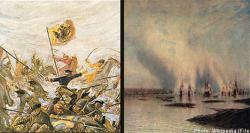 Vistula river - Polish scientists have discovered what appears to be a 17th century ship loaded with looted treasure bound for Sweden dating from the Swedish-Polish war of 1655-60, at the bottom of the Vistula river. During the so-called Deluge during the Great Northern War of 1655-60, Swedish King Karl X Gustaf held Warsaw under siege and looted its treasure chests completely, loading his booty onto ships that, via Gdansk, would carry the swag to Sweden. The vessel found at the bottom of the river is believed to be one of those that were lost. Among the findings are marble relics with the coat of arms of the Vasas, according to the site. Kings of the Swedish Vasa dynasty ruled Poland for more than 80 years; Sigismund III Vasa from 1587 to his death in 1632 and then his sons Vladislav V 1632-1648 and Johan II Kasimir 1648 to 1668. Despite being king of Sweden between 1592 and 1599, Sigismund had been deposed of the throne by his uncle Karl IX. Although it is not clear how much treasure the Swedes took from Poland during the war, the saying goes that after the soldiers had left, not one silver spoon could be found in the manor houses of the Polish countryside, according to the site. The scientists have so far found 70 separate items, in the form of five tonnes of sculptures, decorations, doors, and even pieces of floors at the bottom of the river, and the researchers are confident there is more to be discovered. Scientists believe that these relics are from the Royal Palace in Warsaw and the former Villa Regia, which was later transformed into the Kazimierzowski Palace.
Vistula river - Polish scientists have discovered what appears to be a 17th century ship loaded with looted treasure bound for Sweden dating from the Swedish-Polish war of 1655-60, at the bottom of the Vistula river. During the so-called Deluge during the Great Northern War of 1655-60, Swedish King Karl X Gustaf held Warsaw under siege and looted its treasure chests completely, loading his booty onto ships that, via Gdansk, would carry the swag to Sweden. The vessel found at the bottom of the river is believed to be one of those that were lost. Among the findings are marble relics with the coat of arms of the Vasas, according to the site. Kings of the Swedish Vasa dynasty ruled Poland for more than 80 years; Sigismund III Vasa from 1587 to his death in 1632 and then his sons Vladislav V 1632-1648 and Johan II Kasimir 1648 to 1668. Despite being king of Sweden between 1592 and 1599, Sigismund had been deposed of the throne by his uncle Karl IX. Although it is not clear how much treasure the Swedes took from Poland during the war, the saying goes that after the soldiers had left, not one silver spoon could be found in the manor houses of the Polish countryside, according to the site. The scientists have so far found 70 separate items, in the form of five tonnes of sculptures, decorations, doors, and even pieces of floors at the bottom of the river, and the researchers are confident there is more to be discovered. Scientists believe that these relics are from the Royal Palace in Warsaw and the former Villa Regia, which was later transformed into the Kazimierzowski Palace.
http://www.thelocal.se/37560/20111125/#
TURQUIE – 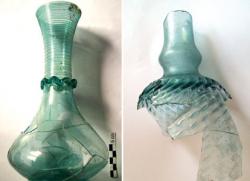 Marmaray - Glasswork from the Roman, Byzantine and Ottoman empires has been discovered during the Marmaray excavations in Istanbul. Experts previously believed Ottomans did not develop a unique glasswork style. Üzlifat Özgümüş said the excavations, which have gone on since 2007, were the world’s largest and the most important excavations. Since Istanbul was the capital of major empires throughout history, he said the city had artifacts from these periods. “These are findings from 2,000 years ago. We have found glass that has been produced from the latest period of the Greeks until the present day.” Glasswork from the Roman period, the professor said, were of higher quality than the ones of Byzantium, adding that the works of the Byzantines and the Romans were very different and that the Roman Empire produced the greatest products. Various objects made from glass, bowls and plates used in daily life reflected forward-thinking, Özgümüş said. “The design of today’s glass and plates was found thousands of years ago – they date back to the third and fourth centuries. For the first time in Turkey, archaeologists have found silvered glass from the Roman period, also known as the Ennion glass – one of the most important findings from the first century. The glass master who created it is from Lebanon and his work has the weight of a well-known brand. The kind of glasswork we found is very limited in the world; it exists in a few special collections and museums.” Özgümüş said brightly colored glass was rarely produced in ancient times. “Glass was light green, blue and brown because they could not refine glasses in that period.” Özgümüş said the colors of the Byzantine and early Ottoman periods were the same. “It is as if that the workmanship and style of glasswork continued without interruption. Ottoman masters and the Byzantine masters worked together. After the Byzantine period, the same art continued into the Ottoman Empire with the use of similar colors. Then colors brightened and we start to see the use of turquoise, for example – one of Ottomans’ most cherished colors. Bottles became larger and the art of glasswork developed a unique Ottoman identity throughout that period. This is what these excavations have found.”
Marmaray - Glasswork from the Roman, Byzantine and Ottoman empires has been discovered during the Marmaray excavations in Istanbul. Experts previously believed Ottomans did not develop a unique glasswork style. Üzlifat Özgümüş said the excavations, which have gone on since 2007, were the world’s largest and the most important excavations. Since Istanbul was the capital of major empires throughout history, he said the city had artifacts from these periods. “These are findings from 2,000 years ago. We have found glass that has been produced from the latest period of the Greeks until the present day.” Glasswork from the Roman period, the professor said, were of higher quality than the ones of Byzantium, adding that the works of the Byzantines and the Romans were very different and that the Roman Empire produced the greatest products. Various objects made from glass, bowls and plates used in daily life reflected forward-thinking, Özgümüş said. “The design of today’s glass and plates was found thousands of years ago – they date back to the third and fourth centuries. For the first time in Turkey, archaeologists have found silvered glass from the Roman period, also known as the Ennion glass – one of the most important findings from the first century. The glass master who created it is from Lebanon and his work has the weight of a well-known brand. The kind of glasswork we found is very limited in the world; it exists in a few special collections and museums.” Özgümüş said brightly colored glass was rarely produced in ancient times. “Glass was light green, blue and brown because they could not refine glasses in that period.” Özgümüş said the colors of the Byzantine and early Ottoman periods were the same. “It is as if that the workmanship and style of glasswork continued without interruption. Ottoman masters and the Byzantine masters worked together. After the Byzantine period, the same art continued into the Ottoman Empire with the use of similar colors. Then colors brightened and we start to see the use of turquoise, for example – one of Ottomans’ most cherished colors. Bottles became larger and the art of glasswork developed a unique Ottoman identity throughout that period. This is what these excavations have found.”
http://www.hurriyetdailynews.com/n.php?n=marmaray-dig-reveals-glasswork-in-ottoman-2011-11-24
FRANCE – 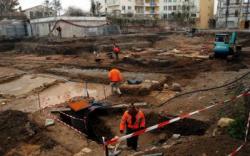 Narbonne - À l'occasion d'une fouille préventive menée par l'INRAP au 14 quai d'Alsace dans le cadre d'un projet d'aménagement immobilier mené par la société Agir Promotion prévoyant 80 logements du T2 au T4, un quartier romain a été mis au jour attestant d'une urbanisation antique de la ville de Narbonne. Les fouilles s'étendant sur une zone couvrant près de 1 000 m2 a livré les vestiges d'une zone fréquentée durant les Ier et IIe siècles de notre ère. Jusqu'ici c'est-à-dire depuis une vingtaine d'années, les fouilles et les résultats des découvertes fortuites attestaient d'une fréquentation des lieux depuis le changement d'ère jusque dans le courant du IIIe siècle, dans ces quartiers les plus septentrionaux de la Capitale Provinciale au plus près du fleuve Atax dont le tracé a été repris par l'actuelle Robine. Ces fouilles attestaient d'une activité avant tout périfluviale et professionnelle. Mais les fouilles en cours ont permis de faire apparaître des vestiges situés près de deux mètres sous le sol, qui s'organisent à partir de deux rues perpendiculaires, dans ce quartier un vraisemblable entrepôt d'une surface de 400 m2, conserve les probables fondations de piliers chargés de supporter le poids d'un étage ou d'une charpente. Un deuxième bâtiment a été localisé à l'est du carrefour, toujours en cours de fouille est pour le moment interprété comme une maison, qui comportait près de dix pièces équipées de sols en béton (chaux, sables, cailloutis) qui ont été dégagés. Des fragments d'enduits muraux ornés de motifs géométriques et végétaux ont également été découverts, ils témoignent de la décoration intérieure de la « domus » et apportent des éléments qui intéressent sa datation et le rang social des propriétaires. Des traces d'occupation plus récente (Ve ou VIe siècle) ont été reconnues sous la forme de sépultures d'enfants inhumés dans des amphores recyclées. Les lieux ne seront plus habités jusqu'au XIXe siècle.
Narbonne - À l'occasion d'une fouille préventive menée par l'INRAP au 14 quai d'Alsace dans le cadre d'un projet d'aménagement immobilier mené par la société Agir Promotion prévoyant 80 logements du T2 au T4, un quartier romain a été mis au jour attestant d'une urbanisation antique de la ville de Narbonne. Les fouilles s'étendant sur une zone couvrant près de 1 000 m2 a livré les vestiges d'une zone fréquentée durant les Ier et IIe siècles de notre ère. Jusqu'ici c'est-à-dire depuis une vingtaine d'années, les fouilles et les résultats des découvertes fortuites attestaient d'une fréquentation des lieux depuis le changement d'ère jusque dans le courant du IIIe siècle, dans ces quartiers les plus septentrionaux de la Capitale Provinciale au plus près du fleuve Atax dont le tracé a été repris par l'actuelle Robine. Ces fouilles attestaient d'une activité avant tout périfluviale et professionnelle. Mais les fouilles en cours ont permis de faire apparaître des vestiges situés près de deux mètres sous le sol, qui s'organisent à partir de deux rues perpendiculaires, dans ce quartier un vraisemblable entrepôt d'une surface de 400 m2, conserve les probables fondations de piliers chargés de supporter le poids d'un étage ou d'une charpente. Un deuxième bâtiment a été localisé à l'est du carrefour, toujours en cours de fouille est pour le moment interprété comme une maison, qui comportait près de dix pièces équipées de sols en béton (chaux, sables, cailloutis) qui ont été dégagés. Des fragments d'enduits muraux ornés de motifs géométriques et végétaux ont également été découverts, ils témoignent de la décoration intérieure de la « domus » et apportent des éléments qui intéressent sa datation et le rang social des propriétaires. Des traces d'occupation plus récente (Ve ou VIe siècle) ont été reconnues sous la forme de sépultures d'enfants inhumés dans des amphores recyclées. Les lieux ne seront plus habités jusqu'au XIXe siècle.
http://www.ladepeche.fr/article/2011/11/27/1225781-un-quartier-romain-mis-au-jour.html
INDE – 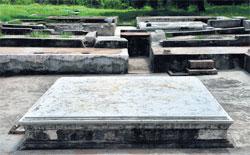 Panchalankuruchi - “A race of rude warriors, habituated to arms and Independence,” was how the late colonel James Welsh described the ‘Southern Poligars’ who ruled this part of the country in the 18th century and whose most dauntless warrior-king was Veerapandiya Kattabomman who valiantly challenged British supremacy. Ruling from Panchalankuruchi, his once-glorious seat of power, 53 km from Tirunelveli, Kattabomman was one of the earliest sub-altern heroes of India’s freedom struggle as the modern era brought the English East India Company to Indian shores. A relentless fighter who was hanged by the British after a swift and unfair trial on Oct 16, 1799, when he was just 39 years, Kattabomman’s saga of courage and sacrifice that began with his refusal to pay taxes to the erstwhile British rulers, is best captured in the discourse of his Fort at Panchalankuruchi rebuilt thrice after three demolitions, only to be finally razed down again. It is a heart-rending melange of human courage, the Poligars’ fight for self-respect, twisted by scenes of betrayal and contingency, architectural marvels and finally a heightened archaeological sense to preserve some of the remnants of Indian modern history, that speak from the now-fenced 36 acres that was once his fort.
Panchalankuruchi - “A race of rude warriors, habituated to arms and Independence,” was how the late colonel James Welsh described the ‘Southern Poligars’ who ruled this part of the country in the 18th century and whose most dauntless warrior-king was Veerapandiya Kattabomman who valiantly challenged British supremacy. Ruling from Panchalankuruchi, his once-glorious seat of power, 53 km from Tirunelveli, Kattabomman was one of the earliest sub-altern heroes of India’s freedom struggle as the modern era brought the English East India Company to Indian shores. A relentless fighter who was hanged by the British after a swift and unfair trial on Oct 16, 1799, when he was just 39 years, Kattabomman’s saga of courage and sacrifice that began with his refusal to pay taxes to the erstwhile British rulers, is best captured in the discourse of his Fort at Panchalankuruchi rebuilt thrice after three demolitions, only to be finally razed down again. It is a heart-rending melange of human courage, the Poligars’ fight for self-respect, twisted by scenes of betrayal and contingency, architectural marvels and finally a heightened archaeological sense to preserve some of the remnants of Indian modern history, that speak from the now-fenced 36 acres that was once his fort.
http://www.deccanherald.com/content/207570/a-fort-built-demolished-thrice.html#top
USA – 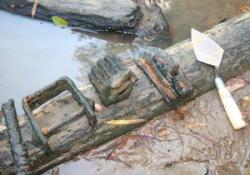 - Bayou Bartholomew - Recent archaeological discoveries in Bayou Bartholomew are getting some ink in state and national publications. The Louisiana Division of Archaeology studied and recorded the first non-American Indian sites in Morehouse Parish during record low water levels in the bayou this year. The ruins and debris field of Vester’s Ferry, a small cable ferry in central Morehouse Parish that fell into disuse circa 1925, have been recorded with the state as Archaeological Site No. 16MO186. In July, archaeologists Dennis Jones and Allen Saltus Jr. studied and identified the hull of a steamboat that sank in Bartholomew in 1873. The Big Horn, one of the largest steamboats ever to travel the bayou, caught fire after her cargo of lime became wet and heated the wooden barrels it was stored in. Contemporary news reports tell of the Big Horn’s captain scuttling the boat so the passengers and crew could escape onto the bayou bank.
- Bayou Bartholomew - Recent archaeological discoveries in Bayou Bartholomew are getting some ink in state and national publications. The Louisiana Division of Archaeology studied and recorded the first non-American Indian sites in Morehouse Parish during record low water levels in the bayou this year. The ruins and debris field of Vester’s Ferry, a small cable ferry in central Morehouse Parish that fell into disuse circa 1925, have been recorded with the state as Archaeological Site No. 16MO186. In July, archaeologists Dennis Jones and Allen Saltus Jr. studied and identified the hull of a steamboat that sank in Bartholomew in 1873. The Big Horn, one of the largest steamboats ever to travel the bayou, caught fire after her cargo of lime became wet and heated the wooden barrels it was stored in. Contemporary news reports tell of the Big Horn’s captain scuttling the boat so the passengers and crew could escape onto the bayou bank.
http://www.bastropenterprise.com/topstories/x778871206/Archaeological-sites-drawing-attention
SOUDAN - Le Soudan est situé sur la région antique et médiévale de la Nubie. Au sud de l’empire égyptien, cette aire culturelle a subi les influences de son voisin du Nord, mais également des influences sub-sahariennes. Certains villages que les équipes canadiennes d’archéologues ont mis à jour ressemblent en effet à des villages maliens, bien plus qu’à des structures égyptiennes. Toutefois, la Nubie possède quelques points communs avec l’Égypte. Le Nil, un des plus longs fleuves du monde, la traverse, et est son « poumon vert ». Il lui permet le transport de marchandises, l’accès à l’eau et l’agriculture. Les pyramides ensuite, qui sont plus nombreuses en Nubie qu’en Égypte, bien que plus petites. Les conditions des fouilles sont néanmoins plus rudimentaires au Soudan
http://www.lemetropolitain.com/nouvelles.asp?nID=15982